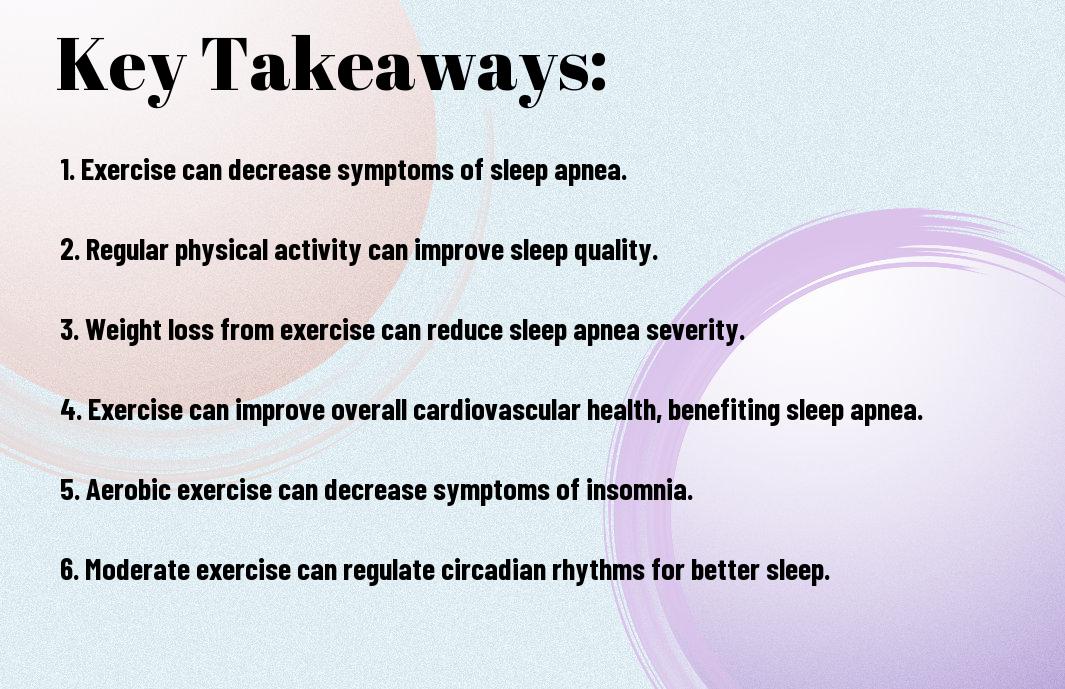Exercising regularly can have a profound impact on individuals suffering from various sleep disorders, including sleep apnea. Research has shown that individuals who engage in regular physical activity experience improvements in their sleep quality, reduced severity of symptoms, and overall better management of their condition. However, understanding the specific types of exercises, intensity, and duration required to achieve these benefits is essential for individuals with sleep disorders. In this post, we will explore the relationship between exercise and sleep disorders, examining the positive effects of physical activity on symptoms and providing guidance for incorporating exercise into a comprehensive sleep disorder treatment plan.
Key Takeaways:
- Exercise can improve symptoms: Research suggests that regular exercise can help improve symptoms of sleep apnea and other sleep disorders. This includes reducing the severity of symptoms and improving sleep quality.
- Types of exercise: Both aerobic and resistance exercises have been found to be effective in improving sleep apnea and other sleep disorders. Aerobic exercises like walking, running, or swimming can help improve cardiovascular health, which can in turn improve sleep quality. Resistance exercises, such as weightlifting, can also have positive effects on sleep.
- Weight loss and sleep apnea: Exercise can help with weight loss, and maintaining a healthy weight can significantly improve symptoms of sleep apnea. Losing even a small amount of weight can make a big difference in reducing the severity of sleep apnea symptoms.
- Consistency is key: It’s important to be consistent with exercise in order to see improvements in sleep apnea and other sleep disorders. Regular, ongoing exercise is more effective in improving symptoms than sporadic or irregular activity.
- Consult a healthcare professional: Before starting any exercise program to improve sleep apnea or other sleep disorders, it’s important to consult a healthcare professional. They can provide personalized recommendations and ensure that exercise is safe and effective for individual needs and health conditions.

The Physiology of Sleep
While the exact mechanisms of sleep are not fully understood, it is clear that sleep is a complex physiological process that involves the coordination of various systems in the body.
Mechanisms of Sleep Regulation
Physiology tells us that the regulation of sleep is influenced by a variety of factors, including the circadian rhythm, the sleep-wake homeostasis, and various neurotransmitters.
The circadian rhythm, often referred to as the body’s internal clock, plays a critical role in regulating the timing of sleep and wakefulness. Additionally, the sleep-wake homeostasis mechanism ensures that the longer a person is awake, the greater the pressure to sleep becomes.
Disruption Patterns in Sleep Disorders
Sleep disorders can disrupt the normal patterns of sleep, leading to difficulties falling asleep, staying asleep, or experiencing poor quality of sleep. These disruptions can have significant negative impacts on overall health and well-being, increasing the risk of various medical conditions.
Patterns such as sleep apnea, insomnia, and restless leg syndrome can all cause serious disruptions in sleep, leading to daytime fatigue, poor concentration, and an increased risk of accidents.
Exercise as a Therapeutic Tool
Now, let’s delve into the potential of exercise as a therapeutic tool for managing sleep apnea and other sleep disorders. Exercise has long been known for its numerous health benefits, but its role in improving sleep quality is gaining more attention in recent years. Research suggests that regular physical activity can have a positive impact on sleep patterns and overall sleep health.
Physical Activity and Its Impact on Health
To understand the potential benefits of exercise for sleep disorders, it’s essential to recognize the broader impact of physical activity on health. Regular exercise has been associated with a reduced risk of developing chronic conditions such as obesity, cardiovascular disease, and diabetes. These conditions are often linked to sleep apnea and other sleep disorders, so managing them through exercise could indirectly improve sleep quality as well.
Studies on Exercise and Sleep Quality
Quality research has also shown a direct link between exercise and improved sleep quality. Studies have demonstrated that individuals who engage in regular exercise tend to experience deeper, more restorative sleep compared to those who are sedentary. Additionally, exercise has been shown to reduce symptoms of sleep disorders and improve overall sleep efficiency.
Exercise interventions, such as aerobic and resistance training, have been found to be effective in improving sleep quality in individuals with sleep disorders. The mechanisms behind this improvement may be related to reduced inflammation, improved mood, and regulation of circadian rhythms.
Tailoring Exercise to Combat Sleep Apnea
Unlike other health conditions, exercise can play a critical role in improving symptoms of sleep apnea and other sleep disorders. Regular physical activity has been shown to reduce the severity of sleep apnea and improve overall sleep quality. Tailoring exercise to combat sleep apnea involves identifying the most beneficial types of exercise and creating practical exercise regimens for patients.
Types of Beneficial Exercise
To combat sleep apnea, aerobic exercise and strength training have been shown to be especially beneficial. Aerobic exercise, such as walking, cycling, or swimming, can help improve overall cardiovascular health and reduce the severity of sleep apnea. Strength training, including exercises targeting the upper airway muscles, can also help to alleviate symptoms. Any exercise program should also include flexibility and balance training to improve overall physical health and well-being.
| Aerobic Exercise | Strength Training |
| Walking | Weight lifting |
| Cycling | Resistance band exercises |
| Swimming | Yoga |
| Running | Pilates |
| Dancing | Body weight exercises |
Importantly, consulting with a healthcare professional before starting any new exercise program is crucial, especially for individuals with sleep apnea or other sleep disorders.
Practical Exercise Regimens for Patients
With the guidance of a healthcare professional or certified personal trainer, individuals with sleep apnea can create practical exercise regimens to help combat their symptoms. Establishing a consistent exercise routine that includes a combination of aerobic, strength, flexibility, and balance training can greatly improve sleep quality and overall health. Additionally, incorporating lifestyle modifications such as healthy eating and stress management can further enhance the benefits of exercise for sleep apnea patients.
The development of customized exercise regimens for patients with sleep apnea is essential in addressing their specific needs and improving their overall quality of life. The inclusion of regular monitoring and adjustments to the exercise program can ensure that patients continue to experience the positive effects of physical activity on their sleep disorder.

Beyond Apnea: Exercise and Various Sleep Maladies
For individuals suffering from sleep disorders beyond Sleep Apnea, there is evidence to suggest that exercise may also have a positive impact on symptoms. This is particularly significant when considering conditions such as insomnia and circadian rhythm disorders, which can severely impact individuals’ overall health and well-being.
Insomnia and Exercise Connections
Beyond Apnea, insomnia is one of the most prevalent sleep disorders affecting millions of people worldwide. Research has shown that regular exercise can have a positive impact on sleep quality and duration, which are key factors in managing insomnia. Physical activity can help regulate the body’s circadian rhythms, promote feelings of relaxation, and reduce symptoms of anxiety and depression, all of which are common contributors to insomnia.
The Role of Exercise in Circadian Rhythm Disorders
Rhythm Disorders, such as Delayed Sleep Phase Disorder and Advanced Sleep Phase Disorder, can significantly disrupt individuals’ circadian rhythms and lead to sleep disturbances. Studies have suggested that engaging in exercise can help regulate the body’s internal clock, which is central to managing these disorders. By promoting changes in body temperature, hormone levels, and metabolism, physical activity can help align individuals’ circadian rhythms with their desired sleep-wake schedule.
Connections among exercise, Circadian Rhythm Disorders and Insomnia highlight the potential of physical activity to improve various sleep maladies. Individuals seeking to mitigate the symptoms of these conditions may find relief through consistent engagement in exercise routines tailored to their specific needs and capabilities.
Can Exercise Improve Symptoms of Sleep Apnea and Other Sleep Disorders?
Considering all points, it is evident that exercise can indeed improve symptoms of sleep apnea and other sleep disorders. Multiple studies have shown a positive correlation between regular physical activity and improved sleep quality, as well as reduced symptoms of sleep apnea. Furthermore, the benefits of exercise as a treatment for sleep apnea are supported by scientific evidence, indicating that incorporating physical activity into a patient’s routine can have a significant impact on their sleep patterns. As such, it is crucial for individuals with sleep disorders to consider incorporating exercise into their daily lives as part of their treatment plan in order to improve their overall sleep quality and well-being. For more information on the benefits of exercise as a treatment for sleep apnea, please visit Exercise as a treatment for sleep apnea.
FAQ
Q: Can exercise improve symptoms of sleep apnea and other sleep disorders?
A: Yes, exercise can indeed improve symptoms of sleep apnea and other sleep disorders. Regular physical activity can help to reduce the severity of sleep apnea by strengthening the muscles in the upper airway, which can prevent collapse during sleep. Additionally, exercise can promote better overall sleep quality, making it an effective non-pharmacological approach to managing sleep disorders.
Q: What types of exercise are most beneficial for improving symptoms of sleep apnea?
A: Aerobic exercises, such as walking, cycling, and swimming, have been shown to be particularly effective in improving symptoms of sleep apnea. These types of activities can help to improve cardiovascular health and increase lung capacity, which can in turn lead to improved breathing and reduced severity of sleep apnea symptoms. Strength training exercises that target the muscles in the upper airway, such as throat and tongue exercises, can also be beneficial.
Q: How much exercise is needed to see improvements in sleep apnea and other sleep disorders?
A: The American Academy of Sleep Medicine recommends that adults engage in at least 150 minutes of moderate aerobic exercise per week, spread out over at least three days. This level of physical activity has been shown to have a positive impact on sleep quality and can help to reduce the severity of sleep apnea and other sleep disorders. However, it’s important to consult with a healthcare professional before starting a new exercise regimen, especially if you have a pre-existing health condition.



